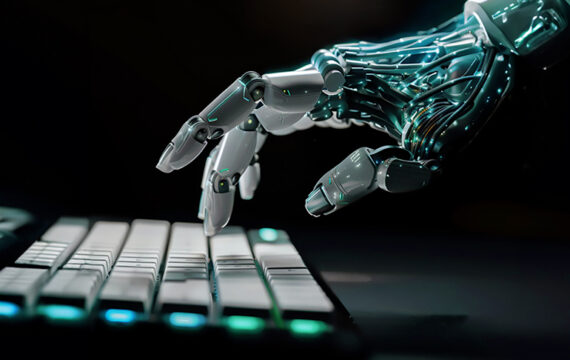Given the immense amount of available data, that’s the question. Thanks to the overwhelming data volume, variety, and velocity, making informed decisions is a constant challenge. The best way to deal with it? Artificial intelligence (AI).
We can’t overstate the importance of artificial intelligence (AI) for decision making. It’s not just that AI approximates human ability to make choices — in situations where decisions are particularly hard to make, AI is often better at making decisions than people are. A recent Gartner survey revealed that 79% of corporate strategists believe AI, automation, and analytics will be the key drivers of business success over the next two years.
Leveraging analytics and AI for more efficient, insightful strategy decisions is one of the biggest challenges, and opportunities, corporate strategists face this year.
In this article, we will explore AI decision making, why it’s important, and how it can help businesses make smarter, faster choices. We’ll look at the limitations of traditional computer and human decision-making processes and explain how and why AI excels at making the decisions that are hardest for humans. We’ll also examine some real-world examples of AI decision making and explain the three critical focus areas for scaling it at your organization.
Finally, we’ll show you how Intellias can help you navigate this transformative technology and address the question on everyone’s mind: Can AI replace human judgment?
What is AI decision making?
Imagine a computer program that can analyze massive amounts of data and make better choices. That’s the power of AI decision-making. Artificial intelligence systems analyze information, like text, images, or even sensor readings. These algorithms can range from simple rules to complex neural networks that guide AI in processing the data and forming conclusions.
Machine learning takes AI decision-making a step further. By learning from past experiences (data and outcomes), AI systems can continuously improve their decision-making abilities. This AI-powered automation helps businesses make faster, more accurate choices in various fields, from retail and finance to telecom & media.
Compare this to traditional human and computer processes. These require complete data, formatted a certain way, and carefully aggregated. Traditional data analysis relies heavily on human expertise and manual processes. Analysts must collect data, clean it, and then use statistical methods to draw conclusions.
It’s very hard for people to make quick decisions when faced with varying opinions from different sources, or when they have a personal stake in the decision. People are also creatures of habit and don’t always learn from past mistakes.
AI can easily manage messy and contradictory input. It can process more data than a person could possibly take in and easily identify the signals in the noise. With machine learning, every decision’s outcome trains the system to make better decisions in the future.
The importance of AI for decision-making
AI’s integration into decision-making processes is transforming industries by enabling more informed, efficient, and effective decisions. Its ability to quickly and accurately analyze vast amounts of data means it’s ideally suited for decision-making in the 21st century.
In principle, generative AI systems can help overcome some of the problems affecting human decision making, such as limited working memory, short attention spans, and decision fatigue, especially when it comes to making decisions under pressure.
Are you curious about how artificial intelligence helps in decision-making? Here are seven ways:
1. Speed decision making
Today, business moves fast, and the ability to make quick decisions is crucial. AI systems can process data and generate insights in real time, enabling organizations to respond swiftly to changing market conditions and customer needs.
By automating data analysis and decision-making processes, AI eliminates the time-consuming tasks of manual data gathering and interpretation. This allows decision-makers to focus on strategic initiatives while AI handles the heavy lifting, ultimately accelerating the decision-making process and providing a competitive edge.
2. Supercharge productivity
Let’s face it, even the most dedicated employees can only work so many hours in a day. That’s where AI comes in. It’s like having a tireless assistant working around the clock to process data and provide insights. Need real-time analysis or rapid solutions? AI has got your back.
By leveraging AI’s ability to work 24/7, people can supercharge their productivity and free up time for strategic thinking and decision-making. Of course, AI is no substitute for human judgment – it’s a tool that enhances our capabilities. Think of it as a productivity booster that helps you work smarter, not harder.
3. Improve accuracy
AI algorithms excel at processing and analyzing vast amounts of structured and unstructured data. By identifying complex patterns, correlations, and anomalies that humans might overlook, AI can provide more accurate insights and predictions.
This enhanced accuracy enables organizations to make better-informed decisions, reducing the risk of errors and ensuring optimal outcomes. AI’s ability to consider multiple variables simultaneously and learn from past experiences further contributes to its superior accuracy in decision-making processes.
4. Reduce risk
AI plays a crucial role in identifying and mitigating potential risks and threats. By analyzing vast amounts of historical data, AI algorithms can detect patterns and anomalies that indicate potential risks, such as fraudulent activities, market fluctuations, or supply chain disruptions.
This early detection allows organizations to proactively mitigate risks and avoid costly mistakes. AI can also run countless scenario simulations and predict potential outcomes, enabling decision-makers to assess the impact of different strategies and make informed choices that minimize risk exposure.

5. Increase efficiency
AI streamlines decision-making processes by eliminating bottlenecks and optimizing workflows. By automating data collection, analysis, and reporting, AI enables decision-makers to access relevant information quickly and easily, eliminating the need for manual data gathering and allowing teams to focus on higher-value tasks.
AI can also identify inefficiencies in existing processes and suggest improvements, leading to increased productivity and operational efficiency. Furthermore, AI’s ability to process data 24/7 ensures that decision-making processes continue uninterrupted, even outside regular business hours.
6. Create consistency
Picture a world where every decision, from the mundane to the monumental, adheres to a meticulously standardized playbook. By leveraging machine learning algorithms and predefined rules, AI promises to ensure that decisions are made consistently across the board, eliminating the fluctuations that can plague human judgment.
Whether approving loans, managing supply chains, or executing repetitive tasks, AI acts as the great equalizer, applying the same criteria and logic every single time. It’s an unwavering consistency that streamlines processes and promotes fairness and impartiality. With AI at the helm, organizations can trust that decisions are made objectively, based on data and established best practices, rather than individual biases or whims.
7. Develop infinite institutional memory
While human employees come and go, AI is an eternal guardian of institutional knowledge. Like a digital sponge, it soaks up every lesson, every insight, and every decision made within the company. It tirelessly analyzes past successes and failures, identifying patterns and best practices that can guide future decision-making. With its limitless capacity for recollection, AI ensures that collective experience is never lost. AI is always ready to provide context and insights based on the company’s history.
By leveraging AI’s infinite institutional memory, organizations can make smarter, more informed decisions that build upon past success while avoiding the pitfalls of yesteryear. AI becomes the keeper of corporate wisdom, ensuring that valuable knowledge is preserved and applied to drive the business forward.
Real-world AI decision making examples across industries

Artificial Intelligence and Machine Learning are revolutionizing decision-making across sectors, from healthcare management and retail to agriculture and travel and hospitality. By analyzing vast amounts of data and learning from patterns, AI systems can make fast, accurate, and personalized decisions that drive efficiency, innovation, and customer satisfaction. Here are some examples of artificial intelligence in business decision-making:
Retail: inventory management at Walmart
Walmart’s AI-driven inventory management system showcases the power of AI in automated decision-making. With traditional methods, it’s tricky for retailers to stay a step ahead of consumer demand. By analyzing vast amounts of data, including sales trends, customer preferences, and supply chain dynamics, the AI algorithm makes autonomous decisions to optimize inventory levels. It accurately predicts future demand, deciding when and how much to reorder for each product.
The system also makes real-time decisions to allocate stock across stores and channels based on local demand patterns. We’ve discussed the power of machine learning to include historical data in future decision making — well, part of this program’s strength is its ability to forget. For example, a freak snowstorm in Florida could potentially mislead an AI system into expecting regular snowstorms. Walmart’s AI system could dismiss the event as an anomaly, and not use it to predict future demand.
This AI-driven approach to inventory management has allowed Walmart to make faster, more precise decisions, reducing stockouts, minimizing waste, and improving the overall customer experience by ensuring product availability.
Agriculture: precision farming at John Deere
Farming has always been an art and a science, dependent on many variables outside of a farmer’s control. John Deere’s precision farming solution leverages AI to make data-driven decisions that optimize agricultural practices. The AI system analyzes a wealth of data from satellite imagery, weather forecasts, and soil sensors to generate real-time recommendations for farmers. Now, instead of referring to many data sources and guesswork, farmers can turn to the AI system for decisions on precisely when, where, and how much to irrigate, fertilize, and apply pesticides.
The algorithms base these decisions on factors like crop type, growth stage, and soil conditions. By making localized, data-driven decisions, the AI helps farmers maximize crop yields, minimize resource waste, and reduce environmental impact. This demonstrates how AI can augment human decision-making in agriculture by providing timely, precise, and actionable insights.
Finance: credit risk assessment
A FinTech company from Phoenix, Arizona, partnered with Intellias to develop a SaaS lending platform that connects borrowers with banks to secure business loans. The platform collects data from borrowers, including credit history, existing loans, and business information, to create comprehensive borrower profiles. It then calculates credit scores and performs an initial qualification round to determine if a borrower meets the criteria for a loan.
We developed a credit score calculator that analyzes data from 3-Bureau Credit Reports to determine loan eligibility and amount, classifying borrowers into different tiers based on their creditworthiness. While human bias can influence manual credit risk evaluations, this AI-powered system makes data-driven decisions on loans, automating the approval process based on borrower data and ML algorithms.
The SaaS lending platform streamlines the loan application process, requiring minimal documentation from borrowers. It offers loans up to $100,000, flexible repayment terms, and support for startups as early as two months after formation. The platform integrates with various third-party services and provides a transparent decision-making process, affordable fees, and the opportunity for borrowers to improve their credit scores. Intellias continues to enhance the platform, focusing on data visualization for better decision-making and implementing machine learning algorithms to improve credit score calculations’ speed and accuracy.
Automotive: decision support for safe driving
Even the safest drivers can find themselves in unsafe situations if they don’t know what’s happening on the road ahead.
Our client, a global mapping software and services company, partnered with Intellias to develop sophisticated software components for navigation and electronic horizon solutions. The project aimed to upgrade the client’s legacy protocol to integrate live traffic data from incident data providers and onboard sensors, enabling vehicles to react and adapt to road conditions at distances of up to a few kilometers.
Intellias gathered and structured map-related and traffic-related data from various sources, including in-vehicle map databases, GPS coordinates, cloud-based real-time traffic feeds, and onboard sensors. This data was then sent to the vehicle’s advanced driver assistance systems (ADAS) to calculate the predicted path and tune active safety aids for fast reaction. The team implemented predictive information sharing to aid the driver’s decision-making, leveraging AI-assisted decision-making to enhance driving safety and comfort.
The partnership resulted in increased efficiency and a 40% reduction in costs. Intellias successfully took over a significant portion of the development activities for the electronic horizon protocol, including development, testing, release management, and production deployment. They also contributed to implementing the next-generation protocol specification, which aimed to provide more detailed road network data and improved performance, further enhancing the system’s AI-assisted decision-making capabilities.
Healthcare: sepsis detection AI at Johns Hopkins
Sepsis is a life-threatening condition caused by the body’s response to infection, and early detection is crucial for effective treatment. With the current standard of care, 30% of patients who develop sepsis will not survive.
A new AI system developed at Johns Hopkins, Targeted, Real-time Early-Warning System (TREWS), analyzes electronic health record data, including vital signs, lab results, and clinical notes, to identify patients at high risk of developing sepsis. In previous attempts to use diigal detection, sepsis was caught less than 20% of the time, and accurate 2–5% of the time.
Research published in Nature Medicine demonstrates that the TREWS system detected 82% of sepsis cases with nearly 40% accuracy. Patients are 20% less likely to die as a result of this new AI-driven system.
The AI algorithm makes real-time decisions based on the analyzed data, alerting healthcare providers to potential sepsis cases up to six hours earlier than traditional methods. This early warning allows for timely intervention, such as administering antibiotics or supportive care, which can significantly improve patient outcomes and reduce mortality rates. The implementation of TREWS at Johns Hopkins Hospital has demonstrated AI’s potential in making critical healthcare decisions, ultimately saving lives and improving the quality of care.
Critically, TREWS isn’t a black box making decision for medical teams. The AI shows doctors why it is making specific recommendations, supporting human decision-making and gaining the trust of providers who use it.
How to scale the adoption of AI-based decision making

AI and decision making go together like peanut butter and jelly. Now you just need to convince the people in your organization. Three key factors will shape the speed and scale of adoption of ai for decision makers: trust, access, and integration.
Trust: Building Confidence in AI Systems
Trust is the foundation of any successful AI implementation. Organizations and individuals must have confidence in the accuracy, fairness, and reliability of AI-driven decisions. AI systems must be transparent, explainable, and accountable to build trust. Companies must provide clear insights into how AI algorithms arrive at their conclusions, ensure that decisions are free from bias, and establish mechanisms for human oversight and intervention when necessary.
Moreover, building trust requires robust data governance practices to ensure the quality, security, and privacy of the data used to train and inform AI models. As organizations prioritize trust-building measures, they better position themselves to harness the full potential of AI in decision-making.
Access: democratizing AI for wide-scale adoption
Access to AI technologies, expertise, and resources is crucial for wide-scale adoption. As AI tools and platforms become more user-friendly and affordable, organizations of all sizes and sectors can leverage AI to enhance their decision-making capabilities. Cloud-based AI services, low-code or no-code platforms, and pre-trained models are democratizing access to AI, allowing businesses to quickly deploy and scale AI solutions without needing extensive in-house expertise.
Furthermore, initiatives to promote AI literacy and skills development will be essential for empowering individuals and teams to use AI in their decision-making processes effectively. As access to AI expands, we can expect to see a surge in AI-driven innovation and transformation across industries.
Integration: seamless embedding of AI into existing systems
The seamless integration of AI into existing decision-making systems and workflows is vital for realizing its full potential. Organizations must focus on developing AI solutions that can easily integrate with their current IT infrastructure, data sources, and business processes. This involves creating open, flexible, and scalable architectures that allow AI to be embedded into various applications and platforms.
Moreover, effective integration requires close collaboration between AI experts, domain specialists, and end-users to ensure that AI solutions are tailored to specific business needs and decision-making contexts. By prioritizing seamless integration, organizations can unlock the value of AI in decision-making while minimizing disruption and maximizing return on investment.
As trust, access, and integration continue to drive the adoption of AI in decision-making, we can anticipate a future where AI-powered insights and recommendations become an integral part of how businesses and individuals make informed, data-driven decisions.
Booz-Allen offers five tips for change management that ease users into the adoption of AI:
- Think Big, Start Small: Define your vision and roll out incrementally, while taking care of the early adopters in your pilot programs.
- Put Your People Front & Center: Apply human-centered design, incorporating technical and nontechnical end users into all phases of the process.
- Equip Them With Knowledge: Meet users where they are, addressing their concerns and educating them to build their confidence and set them up for success.
- Tell It Like It Is: Promote but manage expectations, and be sure to maintain engagement and solicit and respond meaningfully to feedback from all levels of your organization.
- Connect People To One Another: Create opportunities for cross-functional peer-to-peer engagement and learning to build an internal AI community.
These human-centered steps embed AI into the culture of your organization, supporting successful adoption.
Can AI replace humans in decision making?
The examples we looked at show that artificial intelligence can sometimes fully automate and replace human decision-making, particularly for lower-stakes choices. Amazon’s recommendation algorithm runs autonomously, though customers still get the final say on whether to buy.
However, for many important decisions, AI currently serves more to augment and support human decision-makers rather than completely replace them. That’s because AI still lacks the genuine intelligence, emotional awareness, and deep contextual understanding that critical choices often demand. High-impact decisions may be better left to humans.
AI is no substitute for human judgment – it’s a tool that enhances our capabilities.
Decisions involving responsible AI adoption, ethics, social norms, and human values are especially challenging to code into AI systems. While AI can assist with moral choices, people must make the ultimate call and be held accountable. Across many domains, a balanced combination of AI capabilities and human judgment will likely yield the best decision-making processes.
Around the world, a growing body of legislation and policy regulates how organizations use AI and mandates transparency about AI decision making. The most vivid examples are the EU Artificial Intelligence Act, which is the first comprehensive regulation on AI by a major regulator anywhere; or the Colorado AI Act , which is the first comprehensive AI legislation in the United States specifically addressing the risk and potential for bias and discrimination in automated decision making.
Make better, faster decisions with AI
Despite concerns about artificial intelligence, its advantages in decision-making are undeniable in our data-dominated era. AI has become instrumental in processing the immense volume, variety, and velocity of information available today, enabling more informed choices. When AI complements human intelligence in a supervised setting, it can visibly improve business relevance, productivity, and performance. Using AI tools effectively requires some tech know-how, though. But don’t let that stop you from exploring how your unique business can benefit from applying machine-powered intelligence. Get in touch with us, at Intellias, and we’ll help you adopt AI and other modern technologies. We’ll share our expertise to make sure these tools strengthen your success, support your growth and competitive advantage. Ready to apply AI to your decision-making?





